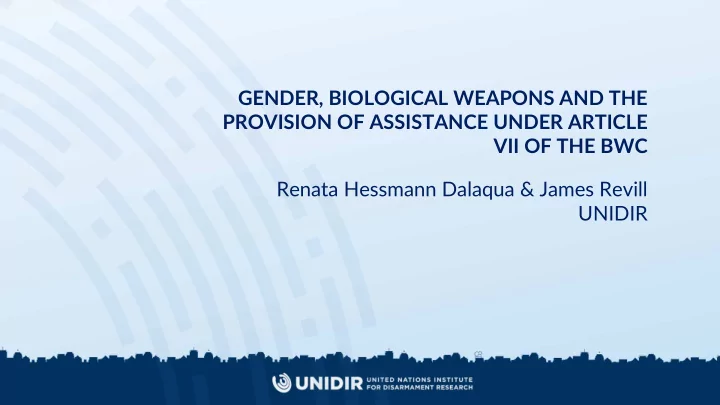

GENDER, BIOLOGICAL WEAPONS AND THE PROVISION OF ASSISTANCE UNDER ARTICLE VII OF THE BWC Renata Hessmann Dalaqua & James Revill UNIDIR
OUTLINE Sex and gender: a primer Operationalizing sex and gender in arms control & disarmament Gender and the provision of assistance So what? Implications for Article VII of the BWC
SEX AND GENDER • Sex relates to physical and biological characteristics that distinguish males and females. • Gender refers to the roles, behaviors, activities, and attributes that a given society considers appropriate at a given time. • Gender norms are socially constructed differences, and they function as social rules of behavior.
OPERATIONALIZING GENDER IN ARMS CONTROL & DISARMAMENT • Provision of age- and gender-sensitive victim assistance (CCM, APMBC Action Plan, TPNW). • Age- and gender-sensitive data-mine risk education (APMBC Action Plan). • Gender-based violence and arms transfers (ATT). • Collection of sex- and age- disaggregated data can lead to a better understanding of the impact of weapons, as well as the barriers that prevent survivors from accessing services.
GENDER & ASSISTANCE SOCIAL ROLES • Gender roles and expectations can lead to different levels of exposure to pathogens. • In many cultures, women are more likely to assume the role of caregivers (both domestically and professionally). • A “good” mother or wife is often associated with the provision of care; the refusal of women to provide care is seen as a “moral failing.”
GENDER & ASSISTANCE INFORMATION & ACCESS • Men and women may have different levels of access to information related to a public health crisis. • Similarly, there may be differences in health care engagement between men and women. • Understanding how different demographics engage with health systems can help in developing effective response strategies.
GENDER & ASSISTANCE STIGMA AND DISCRIMINATION • Infectious diseases have long been associated with stigma and discrimination. • The experience of stigma is often more acute for women, and the consequences of stigmatization for women can be more serious. • It may affect health-seeking behavior and undermine the provision of assistance.
SO WHAT? “ clear awareness of local cultural aspects, including funerary practices, and ability to consider this in the response ” Russian Federation & the United Kingdom, 2018
SO WHAT? Attention to biological difference and gender dynamics might help save lives and improve assistance. Gender roles may result in different levels of exposure, uneven access to information & distinct experiences of social stigma. Communication of public health advice can be made more effective by incorporating gender perspectives. Inadequate information and misinformation can feed stigmatization and affect active case reporting.
HOW TO MOVE FORWARD? Mainstream gender in the public health policies. Incorporate gender perspectives in syllabus and training programmes related to CBRN. Support research that promotes a better understanding of the gendered impacts of diseases. Promote gender in the agenda of BWC meetings.
Recommend
More recommend